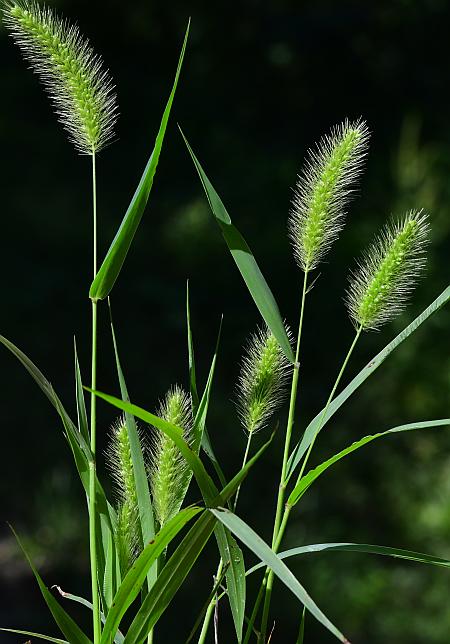Setaria viridis var. viridis
Green Foxtail

Introduced
CC = *
CW = 5
MOC = 52
© SRTurner
Setaria viridis var. viridisGreen Foxtail | |
 |
Introduced CC = * CW = 5 MOC = 52 |
© SRTurner |
|
Family - Poaceae/Paniceae Habit - Annual grass, with soft bases, without rhizomes, relatively easily uprooted, with C4 photosynthesis.
Stems - Flowering stems to 1.0 m, rarely slightly flattened, glabrous. Leaves - Leaf sheaths rounded on the back to slightly keeled, hairy along the margins and glabrous or more commonly roughened on the surface, the ligule a short membrane with a fringe of hairs, 1-3 mm long. Leaf blades 4-25 cm long, 3-15 mm wide, flat, the upper surface roughened, the undersurface roughened or less commonly glabrous.
Inflorescences - Dense, narrow panicles with very short branches of few to many spikelets, appearing as cylindrical spikes, 3-10 cm long, usually erect, the main axis with short, soft, upwardly pointing hairs and often also with longer, soft, ascending to spreading hairs, the spikelets subtended by 1-3 green or rarely purple bristles, these 5-12 mm long.
Spikelets - Spikelets 1.6-2.5 mm long, disarticulating below the glumes. Lower glume 0.5-1.2 mm long. Upper glume 1.6-2.2 mm long. Lowermost floret usually sterile, 1.5-2.5 mm long. Fertile floret with the lemma 1.6-2.1 mm long, with noticeable, fine cross-wrinkles on the surface. Anthers 0.4-0.8 mm long.
Fruits - Caryopses oblong-elliptic in outline. Flowering - June - October. Habitat - Forest openings, prairies, streambanks, pond margins, pastures, fields, lawns, gardens, sidewalks, roadsides, railroads, open disturbed areas. Origin - Probably native to Europe. Lookalikes - Other species of Setaria, also Alopecurus spp. Other info. - Green foxtail is a weedy grass common in many disturbed habitats. It occurs across most of Missouri and is found in every state in the continental U.S., though it is less common in the deep South. Important characters for identification are the hairy leaf sheaths and glabrous upper leaf blade surface. Photographs taken along the Katy Trail near Dutzow, Warren County, MO, 9-5-2021 (SRTurner). |